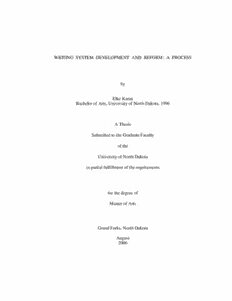Table Of ContentWRITING SYSTEM DEVELOPMENT AND REFORM: A PROCESS
by
Elke Karan
Bachelor of Arts, University of North Dakota, 1996
A Thesis
Submitted to the Graduate Faculty
of the
University of North Dakota
in partial fulfillment of the requirements
for the degree of
Master of Arts
Grand Forks, North Dakota
August
2006
© 2006 Elke Karan
Photographs by Mr. Daniel Sayo-Tomte
© 2005 ACATBA, Central African Republic, used by permission
Map of the Central African Republic
© SIL International, used by permission
ii
This thesis, submitted by Elke Karan in partial fulfillment of the requirements for
the Degree of Master of Arts from the University of North Dakota, has been read by the
Faculty Advisory Committee under whom the work has been done and is hereby
approved.
____________________________
Dr. David J. Weber, chair
____________________________
Dr. John M. Clifton
____________________________
Dr. J. Albert Bickford
This thesis meets the standards for appearance, conforms to the style and format
requirements of the Graduate School of the University of North Dakota, and is hereby
approved.
____________________________________
Dean of the Graduate School
____________________________________
Date
ii i
PERMISSION
Title Writing System Development and Reform: A Process
Department Linguistics
Degree Master of Arts
In presenting this thesis in partial fulfillment of the requirements for a graduate
degree from the University of North Dakota, I agree that the library of this University
shall make it freely available for inspection. I further agree that permission for extensive
copying for scholarly purposes may be granted by the professor who supervised my thesis
work or, in his absence, by the chairperson of the department or the dean of the Graduate
School. It is understood that any copying or publication or other use of this thesis or part
thereof for financial gain shall not be allowed without my written permission. It is also
understood that due recognition shall be given to me and to the University of North
Dakota in any scholarly use which may be made of any material in my thesis.
Signature _______________________
Date _______________________
iv
TABLE OF CONTENTS
LIST OF FIGURES............................................................................................................ix
LIST OF TABLES..............................................................................................................x
LIST OF ABBREVIATIONS, SYMBOLS, AND ACRONYMS....................................xii
ACKNOWLEDGEMENTS.............................................................................................xiv
ABSTRACT......................................................................................................................xv
CHAPTER
1. INTRODUCTION...................................................................................................1
2. FROM OBSCURITY INTO THE LIMELIGHT.....................................................4
3. TWO GLOBAL MOVEMENTS.............................................................................8
3.1 Saving languages from death.....................................................................8
3.2 Education for All.....................................................................................13
4. LITERATURE REVIEW......................................................................................17
4.1 Before 1985.............................................................................................17
4.2 1985–2006...............................................................................................21
4.3 Specific topics.........................................................................................24
5. DEFINITIONS.......................................................................................................29
5.1 Writing.....................................................................................................29
5.2 Writing system.........................................................................................29
v
5.3 Orthography.............................................................................................31
5.4 Script........................................................................................................32
6. WRITING SYSTEM TYPOLOGY.......................................................................34
6.1 The notion of evolution associated with writing systems........................34
6.2 Logographic systems...............................................................................35
6.3 Syllabaries...............................................................................................38
6.4 Abjads......................................................................................................44
6.5 Alphabets.................................................................................................51
6.6 Alphasyllabaries......................................................................................54
6.7 Featural system........................................................................................57
6.8 Mixed systems.........................................................................................59
6.9 Multiple scripts for one language............................................................62
7. PRINCIPLES OF ORTHOGRAPHY DESIGN AND REFORM.........................64
7.1 Design options.........................................................................................65
7.2 Linguistic factors which influence orthographies....................................69
7.3 Synopsis.................................................................................................107
8. NON-LINGUISTIC FACTORS..........................................................................109
8.1 Political factors......................................................................................109
8.2 Social and sociolinguistic factors..........................................................112
8.3 Educational factors................................................................................120
8.4 Technical factors....................................................................................148
v i
9. ADAPTING WRITING SYSTEMS....................................................................155
9.1 Roman alphabets...................................................................................156
9.2 Cyrillic...................................................................................................162
9.3 Arabic....................................................................................................165
9.4 Abugidas................................................................................................170
9.5 Orthography testing...............................................................................177
10. ORTHOGRAPHY REFORM: SPECIAL CONSIDERATIONS......................185
10.1 Motivations for reform and revision......................................................186
10.2 Types of reform.....................................................................................194
10.3 Resistance to reform..............................................................................196
11. ORTHOGRAPHY REFORM CASE STUDIES...............................................204
11.1 Script replacements................................................................................204
11.2 Revision as part of the orthography design process..............................213
11.3 Reform of languages with a literary tradition........................................223
12. SANGO ….........................................................................................................238
12.1 Sango: language of wider communication and of the churches............238
12.2 Statistics and the spread of Sango.........................................................240
12.3 Classification and vocabulary base........................................................241
12.4 Sango grammatical structure.................................................................243
12.5 The phonology of Sango........................................................................247
12.6 Literacy rates..........................................................................................251
12.7 Sango literature......................................................................................251
vi i
12.8 The socio-political situation and the status of Sango............................255
12.9 The Sango orthography before 1984.....................................................263
12.10 The 1984 orthography decree................................................................269
12.11 The role of SIL International.................................................................279
12.12 Current practices....................................................................................285
12.13 New developments................................................................................301
12.14 Relating the Sango orthography 1984 reform to other case studies......306
13. SUMMARY.......................................................................................................310
13.1 Appropriate stakeholder involvement...................................................311
13.2 Orthography as a work in progress........................................................311
13.3 Weighing and balancing all the factors.................................................311
13.4 Testing the writing system.....................................................................312
13.5 Anticipating and dealing with conflict..................................................313
13.6 Taking a conservative approach............................................................313
13.7 Exercising patience and diplomacy.......................................................314
13.8 Establishing support structures..............................................................315
13.9 Conclusion.............................................................................................315
APPENDIX A..................................................................................................................316
APPENDIX B..................................................................................................................318
REFERENCES CITED....................................................................................................321
vi ii
LIST OF FIGURES
Figure Page
1. World map: number and distribution of languages near extinction........................9
2. German school reader using two scripts.............................................................207
3. Antiqua, Sütterlin, and Latin scripts in an official document.............................209
4. Map of the Central African Republic..................................................................238
5. “No spitting” prohibition....................................................................................293
6. Months of the year..............................................................................................293
7. Information Desk................................................................................................294
8. Clubfoot information poster................................................................................294
9. AIDS: Call to action, Airport Road....................................................................295
10. AIDS: Call to action, Boyrabe District...............................................................296
11. AIDS: Call to action, Avenue des Martyrs.........................................................296
12. Protecting the unborn against AIDS...................................................................297
13. Nursing babies is best.........................................................................................297
14. Advertising..........................................................................................................298
ix
LIST OF TABLES
Table Page
1. Katakana syllables illustrating phonemic similarity but not graphic similarity....39
2. Sample characters from the Mende syllabary.......................................................40
3. Sample Roman script alphabets............................................................................52
4. Sample Amharic syllables.....................................................................................54
5. Sample Cree syllables...........................................................................................57
6. Tone notation in Attie...........................................................................................99
7. UNESCO symbol choice recommendations.......................................................130
8. Symbolization of two common African sounds, /ɓ/ and /ɣ/...............................160
9. The Roman alphabet expanded: miscellaneous practices in Africa....................161
10. A selection of Cyrillic characters not used in Russian........................................164
11. Multi-letter graphemes in Abkhaz and Kabardian..............................................165
12. Arabic variant letter forms of two consonants....................................................167
13. Sample conjuncts from Devanagari....................................................................172
14. Comparison of Amharic and Tigrinya vowel values..........................................176
15. Marking Tagakaulu completive aspect...............................................................219
16. Sango vowels......................................................................................................247
17. Sango consonants................................................................................................248
18. Comparison of old and new conventions............................................................274
x

